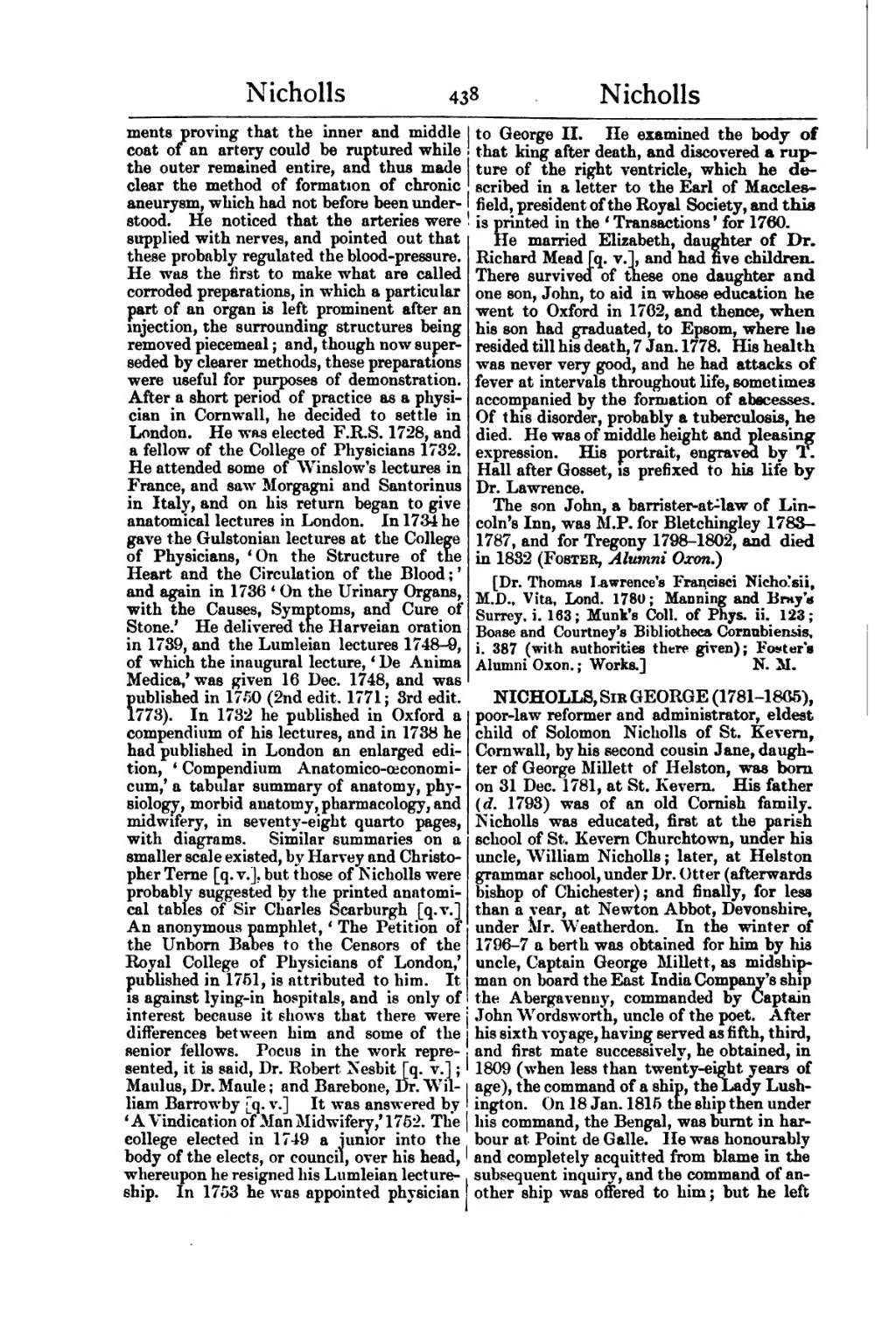ments proving that the inner and middle coat of an artery could be ruptured while the outer remained entire, and thus made clear the method of formation of chronic aneurysm, which had not before been understood. He noticed that the arteries were supplied with nerves, and pointed out that these probably regulated the blood-pressure. He was the first to make what are called corroded preparations, in which a particular part of an organ is left prominent after an injection, the surrounding structures being removed piecemeal; and, though now superseded by clearer methods, these preparations were useful for purposes of demonstration. After a short period of practice as a physician in Cornwall, he decided to settle in London. He was elected F.R.S. 1728, and a fellow of the College of Physicians 1732. He attended some of Winslow's lectures in France, and saw Morgagni and Santorinus in Italy, and on his return began to give anatomical lectures in London. In 1734 he gave the Gulstonian lectures at the College of Physicians, ‘On the Structure of the Heart and the Circulation of the Blood;’ and again in 1736 ‘On the Urinary Organs, with the Causes, Symptoms, and Cure of Stone.’ He delivered the Harveian oration in 1739, and the Lumleian lectures 1748–9, of which the inaugural lecture, ‘De Anima Medica,’ was given 16 Dec. 1748, and was published in 1750 (2nd edit. 1771; 3rd edit. 1773). In 1732 he published in Oxford a compendium of his lectures, and in 1738 he had published in London an enlarged edition, ‘Compendium Anatomico-œconomicum,’ a tabular summary of anatomy, physiology, morbid anatomy, pharmacology, and midwifery, in seventy-eight quarto pages, with diagrams. Similar summaries on a smaller scale existed, by Harvey and Christopher Terne [q. v.], but those of Nicholls were probably suggested by the printed anatomical tables of Sir Charles Scarburgh [q. v.] An anonymous pamphlet, ‘The Petition of the Unborn Babes to the Censors of the Royal College of Physicians of London,’ published in 1751, is attributed to him. It is against lying-in hospitals, and is only of interest because it shows that there were differences between him and some of the senior fellows. Pocus in the work represented, it is said, Dr. Robert Nesbit [q. v.]; Maulus, Dr. Maule; and Barebone, Dr. William Barrowby [q. v.] It was answered by ‘A Vindication of Man Midwifery,’ 1752. The college elected in 1749 a junior into the body of the elects, or council, over his head, whereupon he resigned his Lumleian lectureship. In 1753 he was appointed physician to George II. He examined the body of that king after death, and discovered a rupture of the right ventricle, which he described in a letter to the Earl of Macclesfield, president of the Royal Society, and this is printed in the ‘Transactions’ for 1760.
He married Elizabeth, daughter of Dr. Richard Mead [q. v.], and had five children. There survived of these one daughter and one son, John, to aid in whose education he went to Oxford in 1762, and thence, when his son had graduated, to Epsom, where he resided till his death, 7 Jan. 1778. His health was never very good, and he had attacks of fever at intervals throughout life, sometimes accompanied by the formation of abscesses. Of this disorder, probably a tuberculosis, he died. He was of middle height and pleasing expression. His portrait, engraved by T. Hall after Gosset, is prefixed to his life by Dr. Lawrence.
The son John, a barrister-at-law of Lincoln's Inn, was M.P. for Bletchingley 1783–1787, and for Tregony 1798–1802, and died in 1832 (Foster, Alumni Oxon.)
[Dr. Thomas Lawrence's Francisci Nicholsii, M.D., Vita, Lond. 1780; Manning and Bray's Surrey, i. 163; Munk's Coll. of Phys. ii. 123; Boase and Courtney's Bibliotheca Cornubiensis, i. 387 (with authorities there given); Foster's Alumni Oxon.; Works.]
NICHOLLS, Sir GEORGE (1781–1865), poor-law reformer and administrator, eldest child of Solomon Nicholls of St. Kevern, Cornwall, by his second cousin Jane, daughter of George Millett of Helston, was born on 31 Dec. 1781, at St. Kevern. His father (d. 1793) was of an old Cornish family. Nicholls was educated, first at the parish school of St. Kevern Churchtown, under his uncle, William Nicholls; later, at Helston grammar school, under Dr. Otter (afterwards bishop of Chichester); and finally, for less than a year, at Newton Abbot, Devonshire, under Mr. Weatherdon. In the winter of 1796–7 a berth was obtained for him by his uncle, Captain George Millett, as midshipman on board the East India Company's ship the Abergavenny, commanded by Captain John Wordsworth, uncle of the poet. After his sixth voyage, having served as fifth, third, and first mate successively, he obtained, in 1809 (when less than twenty-eight years of age), the command of a ship, the Lady Lushington. On 18 Jan. 1815 the ship then under his command, the Bengal, was burnt in harbour at Point de Galle. He was honourably and completely acquitted from blame in the subsequent inquiry, and the command of another ship was offered to him; but he left
